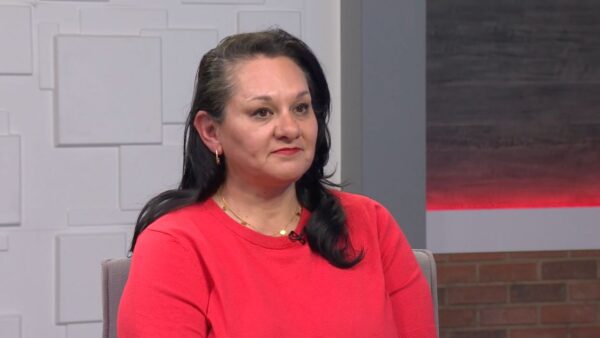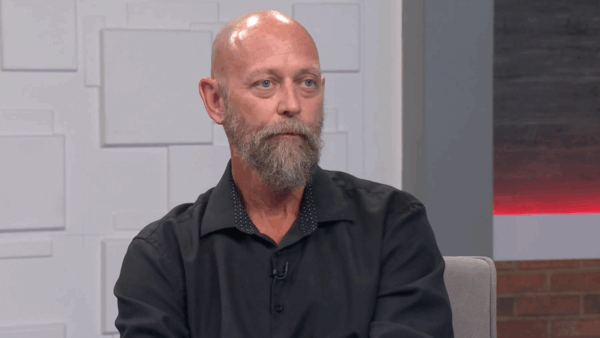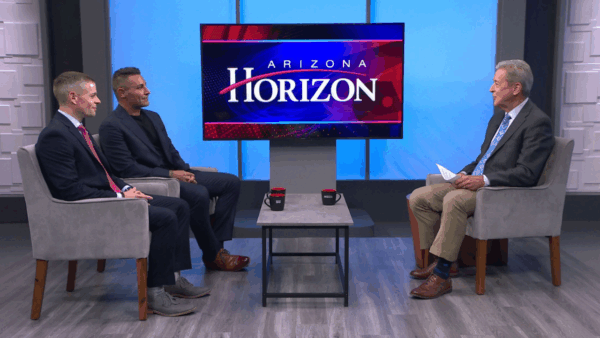Registration for the Health Insurance Marketplace starts October 1. The regional administrator for Arizona’s Medicaid program, David Sayen, will discuss the Marketplace, how it works, and how Arizonans without health insurance can get ready to enroll in coverage.
Ted Simons: Registration for Arizona's health insurance marketplace starts tomorrow. Tonight, we focus on what to expect regarding the healthcare exchange. We start with a recent conversation with David Siyen, the regional administrator for Arizona's Medicare and Medicaid program.
Ted Simons: Good to have you here.
Ted Simons: Let's start with so much to talk about. Let's define terms. The health insurance marketplace. What are we talking about?
David Sayen: We're talking about something as simple as a marketplace where you would go and there are vendors selling their produce. You can look at the produce at the different produce and decide what you like. It's that simple of a concept so that we'll have health plans available for people to choose from. People have choice. They will be available on an internet site. It can also be accessed by telephone operators or even you can apply on paper for this thing. Basically there you've got a choice of health plans so you have a choice that may represent different doctors and hospitals that are available. You've got eligibility for subsidies, so there's almost a million people in Arizona without health insurance. Some studies show that somebody dies every day because they adopt have health insurance in Arizona that they don't get care that they need. We're going to fix that because more than half of those people are going to be eligible for subsidies under the law that will reduce the premiums they have to pay. Perhaps the most important thing is everyone eligible as long as they are a citizen or legal resident of the United States with an address they can use. There is no discrimination for people because they were ill in the past or they may have a genetic condition. There's none of that. Everyone is welcome to have insurance.
Ted Simons: Interesting. No denial due to illness, no denial due to medical condition.
David Sayen: That's right.
Ted Simons: Sounds like one stop shopping for basically the essentials.
David Sayen: What we're trying to do is to facilitate this marketplace where you go and whether it turns out you may be eligible for the access Medicaid program if your income is lower or for a subsidy or if you would like to buy different health insurance and shop you can do that. But when you look at automobiles you have a large SUV, you have the convertible, you have these categories, same thing here. Four categories of plans: Bronze, Silver, Gold, Platinum. The difference is you can pay a higher premium and then have lower costs during the year or you can choose a lower premium, take a little bit of a chance, maybe you'll save money if you don't have much needs. They will cover the same ten essential benefits. That's important.
Ted Simons: Talk about those essential benefits. Are we talking hospitalization, drugs?
David Sayen: Hospitalization, outpatient prescriptions, outpatient care, physician services, laboratory, maternity and new baby care, basically all the things that you need to take care of your health.
Ted Simons: Those are all required.
David Sayen: All the plans are required to offer the ten essential benefits. Some may go a little further and have a richer benefit but the premium might be higher.
Ted Simons: Again, we're talking basics. These are all private firms.
David Sayen: That's right. It's a marketplace of individual vendors, if you will, just like the example of a farmers market, so it's not government insurance. Our role here as insurance commissioners do as well is to simply regulate that marketplace so that the issuers can benefit from a healthy competition and taxpayers and consumers in this case have an opportunity to make a meaningful choice.
Ted Simons: Do we have an idea how much these health plans will cost? Any level at all?
David Sayen: Right. We are not going to post the premiums until we have signed the agreements with all of the plans so that we have a full story to tell. We're in the middle of finalizing discussions now. I can guarantee you on October 1 folks will be looking at the premiums. I can tell you other states who have decided to run their own exchange, California, for example, Massachusetts, have published their rates and they are competitive and in many cases better than what was expected.
Ted Simons: You can find out again if you're eligible for low cost -- are there free plans as well?
David Sayen: Let's start from the bottom. For folks that have a very low income, less than 133 percent of the poverty level, less than 15,000 for an individual, 31,000 for a family of four, those folks don't pay anything because they qualify for access. If they come to our health insurance marketplace portal or one of our navigators helps them, when our system determines you're eligible to be in Arizona's Medicaid program, that's where they are going to go. The system will take them there and get them enrolled. If their income is higher than that the system will take a look and see if they are eligible for a reduction in the cost of their insurance. That happens on a scale from that 133% all the way up to 400% of the federal poverty level, which doesn't mean much to viewers but $94,200 probably does mean something. That is the level at which the subsidy would stop for a family of four. After that you're just buying insurance. This program isn't just for poor people or people that can't afford insurance. Anyone can go to the exchange and buy insurance. What's important is there's a lot of people that we would think of as middle class folks that are going to get a reduction in the cost of insurance because we're going to pay part of the premium for them and they will pay the difference.
Ted Simons: Interesting. Children's health insurance programs. Are they out there?
David Sayen: Well, lower income children have access to care through Arizona's access program, but when we get into the people in the middle class, these programs are available for kids, moms, whomever. You may have a family where my employer provides health insurance but not for my son. I can buy a policy on the exchange for my son regardless of health status.
Ted Simons: Everything you've talked about right now makes sense when we're talking about it. When you go to the computer on October 1 or go to the telephone or there's a variety, but when you go there, is this laid out for you? Is it -- how complicated is the application process?
David Sayen: Well, I can tell you I was at our headquarters back east last week and actually had an opportunity to test-drive the application process myself. It's really quite simple because it asks you one question at a time. Where do you live? What do you expect your income to be next year, a few facts like this. The system behind the scenes goes out and verifies that these facts are correct using a facility that we call the hub which just yesterday passed its tests for readiness to start, and then it says, you know, discount as they say on the TV commercials. It may say you're eligible for a reduction in your premium of a certain amount. Then you can browse the plans that are available. This reduction comes in the form of, a little wonkish, an advanced paid tax credit. What you're doing is you're getting our friends in the Internal Revenue Service are giving you money. They are going to give money every month when you pay your premium they will pay a share of it or you can delay it until later. The point is when you get to the tax return the following year you'll square up this credit. So if for example you were unemployed and you get employed during the year you can go back to the marketplace and say my income has changed and they will adjust that for you like you might adjust your withholding for another child. Then that's where it gets adjudicated. If we paid someone too much it will come back. If we didn't pay as much as we should have, say you lost your job in the middle of the year and didn't tell us, you could recover some money there as well.
Ted Simons: When you get to the application process it's like a variety of things you do online where you can get fitted for a golf ball or something like that. You press a thing, continue. Press a thing, continue. What you're explaining can be complicated, especially to folks who may not be all that well-versed in nomenclature of insurance and legalese. They want to know, can they fill out the application, and once you're filling it out and I have options can I figure out what the options offer?
David Sayen: This is the thing, the transparency, the opportunity for choice we think is powerful. If I have a kid say she's got Asperger's, a problem some kids have, and I need to buy insurance, I have to go to the different insurers, fill out some sophisticated things about the illnesses and half of them will say no and the rest maybe they will offer me products at different prices that don't match up. There's no way I'm going to make a good choice. Here all the plans offer the same benefit package. The basic package. They are all available to me. They are in lock step with this Bronze, Silver, Gold thing where I can figure out what premium I want to pay versus how much risky want to bear. That's a much more logical way to make things work. We have a capitalist system in our country and it's great but sometimes these systems are helped by having a little structure to make the marketplace work better.
Ted Simons: The structure means comparing prices, benefits, comparing quality of plans?
David Sayen: Well, that's an interesting point. The plans that will be offered on October 1, the products as the issuers call them, they didn't exist prior to the 1st. So while we could give you information about this insurance company's pretty good or that one, it wouldn't work so well. What we're going to see is we'll know if it's a company that has accreditation or some qualification that's worth knowing, but in terms of reading the plans, that's going to happen when we get into the next year and people have experience with the actual products in the exchange from that issuer.
Ted Simons: I want to -- will those ratings be like Amazon with five stars? How do you figure that out?
David Sayen: We have been in this business a long time. I worked for CMS for 34 years. We have been administering the Medicare program since 1964. About half the people in the Medicare program in Arizona actually get Medicare from private plan called Medicare Advantage plans. All the folks who have the Medicare prescription drug program get that from a private plan. The way we do this, we have an engine like the marketplace called the plan finder, and if you're a Medicare beneficiary interested in a drug plan, you say, this is where I live, this is pharmacy I like. I need this drug in this dosage and this and that. Then we pull the lever and the program figures out this program is going to have the cheapest overall cost for you considering your dosage and these other things, then this one and that one and we give the plans one to five stars. For the past few years we did a demonstration in the Medicare Advantage side where we paid the plans that had five stars more money every month, which they used to enroll more people and we drove people toward quality plans. That's exactly what's going to happen in the marketplace. We will tell people the plans with the higher satisfaction. We'll survey people and then drive people toward those. We're also going to look for plans with better health outcomes by making sure people have preventive services.
Ted Simons: There will be accountability relatively soon?
David Sayen: relatively soon.
Ted Simons: Okay. Again, I'm back now trying to figure out what I'm doing on October 1, 2 or 3, I figured out I have gone through the process, I have done everything. Made my choices. I enter and whatever the screen says thank you, good luck and God bless. What if November comes and I say, I think I want to change that. I'm not sure I want plan A. I may want to go with plan B, with this other company. How often can you change?
David Sayen: I gave a talk today and a gentleman compared this in his example to a sale at a big box retailer where the store was going to close on a particular night and you could line up outside and there would be a 70% discount in the morning and people got mobbed at the store like on Thanksgiving. This is not like that. There's nothing special about October 1st. The first enrollment period is six months long. So people have until March to decide if they want to participate. You can go through the application and save it much as you would start a shopping cart in one of the other internet sites and think about it. So the way this works is you're going to go through, work through the business about the subsidy. If it looks like you're eligible for that, then you're going to say, let me see the plans. Then you'll see the plans and their information and pick one. When you pick one the computer will say, thanks very much. Welcome to XXX insurance plan. Now you'll do the particulars with them about paying your premium, which doctor you would like to see, and so forth. Or you could say I want to talk to my friend who is a nurse. I want to talk to my cousin. Whatever. We think care-givers and family and pastors and teachers are really important in this process. Not a lot of people make this decision for themselves. Frankly I'm hoping for some of the younger folks who may have a little trouble with this mom is going to say, you need to have health insurance, may help them pay for it. It's kind of a family and community thing. I love working here in Arizona because we have so many partners in the healthcare community that are really interested in helping people find their way through and get the right coverage.
Ted Simons: Should folks be preparing now to enroll or is it just basically wait until October 1st and take it from there?
David Sayen: You can go on our healthcare.gov website today and learn about how coverage works, what the benefits are, how the reduction works for those people that qualify for the advanced paid tax credit. But you really don't have to do anything much but wait a little bit and then in October as I said you've got plenty of time. I didn't answer your question. I'll be clear. If you choose a plan in October and change your mind in November, remember that the coverage doesn't start until January 1st. So the plan that you're enrolled in on December 15th, that's your plan. Now you're in. For people who decide to go a little slower, their start dates will be February 1, March 1, April 1. Then we're done and it becomes an annual event.
Ted Simons: Okay. One more question. Businesses. We're talking about individuals for the most part here. Anything special businesses need to be doing now to prepare for this?
David Sayen: Well, there's a couple of things that are important. The great majority of large businesses provide health insurance for their workers. When we get into the smaller businesses where jobs are often created as we well know, we're helping businesses that have fewer than 25 employees by offering them the opportunity to purchase insurance through a special marketplace we call it the SHOP, that has its own plan available, has an 800 number. There's a tax credit available that can be worth as much as 50% of the employer's contribution. This is important. If I want to start up a company and try to challenge Google, Google can give health insurance cheaper because they are huge. I can't. Now I'll have that opportunity. I think that's very important.
Ted Simons: For businesses, healthcare.gov, get your answers there?
David Sayen: That will take them to the small business site.
Ted Simons: There's a lot of information there. Thanks so much for joining us. We'll see what happens come October 1, 2, 3, and forward.
David Sayen: We sure will. Thank you.
David Sayen:Regional Administrator, Arizona's Medicaid program;























